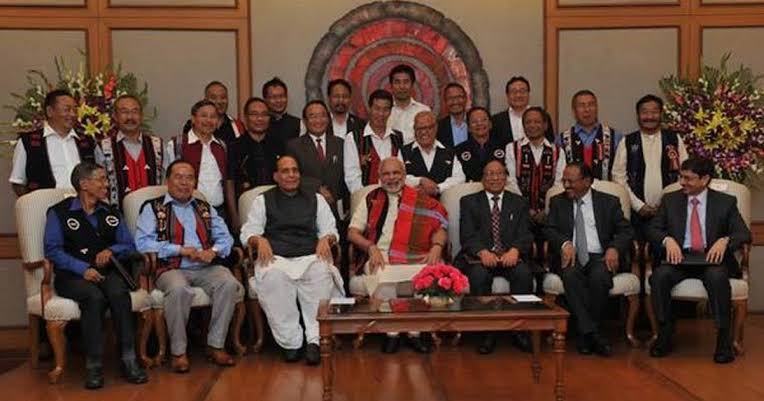
Details of 2015 Naga Agreement
A report on the security situation in the Northeastern states was tabled by the Parliamentary Standing Committee on Home Affairs in the Rajya Sabha. The report contained the details of the framework agreement signed between the National Socialist Council of Nagaland-Isak-Muivah (NSCN-IM) and the Union government.
• The framework agreement was signed in August 2015, after NSCN-IM agreed on a settlement within the Indian federation with a “special status.”
• An inclusive settlement will be within the Indian federation due to regards to the uniqueness of Naga history.
Key Findings of the Report
• The Nagas have now reached a common understanding with the government that boundaries of the States will not be touched. Initially, the Nagas had stuck to the idea of unification of Naga inhabited areas resolutely maintaining their stand of ‘no integration, no solution.’ The NSCN-IM has been fighting for ‘Greater Nagaland’ or Nagalim — it wants to extend Nagaland’s borders by including Naga-dominated areas in neighbouring Assam, Manipur and Arunachal Pradesh, to unite 1.2 million Nagas.
• Article 371A, which guarantees special constitutional status to Nagaland, could also be extended to Naga-inhabited areas in neighbouring Manipur, Assam and Arunachal Pradesh.
• The “contours” had not been spelt out in the framework agreement. The government of India has always recognised the uniqueness of the Naga history. Historically, Nagas do not consider themselves as Indians and stress upon their sovereignty. They have emphasized on the fact that any settlement could be reached only on the basis of the fact that this is a settlement between two sovereigns.
• The report has also noted that Naga Peace Talks will have to be expedited to ensure peace in the region as Naga groups and Tribal bodies are getting restless.
Background
• The British annexed Assam in 1826, and in 1881, the Naga Hills too became part of British India. In 1946 the Naga National Council (NNC) was formed, which declared Nagaland an independent state on August 14, 1947. The NNC resolved to establish a sovereign Naga state and conducted a referendum in 1951, in which 99% people supported an independent Nagaland.
• In March 1952, the underground Naga Federal Government (NFG) and the Naga Federal Army (NFA) was formed. The Government of India sent in the Army to crush the insurgency and, in 1958, enacted the Armed Forces (Special Powers) Act.
• In November 1975, the government got a section of NNC leaders to sign the Shillong Accord, under which the section of NNC and NFG agreed to give up arms.
• A group of about 140 members led by Thuingaleng Muivah, who was in China at that time, refused to accept the Shillong Accord, and formed the National Socialist Council of Nagaland in 1980.
• In 1988, the NSCN split into NSCN (IM) and NSCN (K) after a violent clash.
Article 371A
• The Acts of Parliament relating to the following matters would not apply to Nagaland unless decided by the State Legislative Assembly:
religious or social practices of the Nagas
Naga customary law and procedure
administration of civil and criminal justice involving decisions according to Naga customary law
ownership and transfer of land and its resources
NOTE: Nagaland was formed out of the Naga Hills district of Assam and the then North East Frontier Agency (NEFA) province (now Arunachal Pradesh) in 1963.
• The Governor of Nagaland shall have special responsibility for law and order in the state so long as internal disturbances caused by the hostile Nagas continue. In the discharge of this responsibility, the Governor, after consulting the Council of Ministers, exercises his individual judgement and his decision is final. This special responsibility of the Governor shall cease when the President so directs.
• The Governor has to ensure that the money provided by the Central Government for any specific purpose is included in the demand for a grant relating to that purpose and not in any other demand moved in the State Legislative Assembly.












